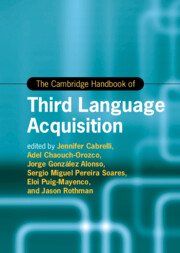Book contents
- The Cambridge Handbook of Third Language Acquisition
- Cambridge Handbooks in Language and Linguistics
- The Cambridge Handbook of Third Language Acquisition
- Copyright page
- Contents
- Figures
- Tables
- Contributors
- Introduction Multilingualism
- Part I Theoretical Approaches to L3/Ln
- Part II L3/Ln across Linguistic Domains
- Part III Becoming and Staying Multilingual at Different Ages
- Part IV L3/Ln in Action
- 16 Theoretical Linguistic Approaches to Multilingual Code-Switching
- 17 Psycholinguistics of Multilingual Code-Switching
- 18 Third Language Acquisition in the Classroom
- 19 Diversity in Multilingual Learners
- Part V L3/Ln and Cognition
- Part VI Research Methods in L3/Ln
- Index
- References
16 - Theoretical Linguistic Approaches to Multilingual Code-Switching
from Part IV - L3/Ln in Action
Published online by Cambridge University Press: 13 July 2023
- The Cambridge Handbook of Third Language Acquisition
- Cambridge Handbooks in Language and Linguistics
- The Cambridge Handbook of Third Language Acquisition
- Copyright page
- Contents
- Figures
- Tables
- Contributors
- Introduction Multilingualism
- Part I Theoretical Approaches to L3/Ln
- Part II L3/Ln across Linguistic Domains
- Part III Becoming and Staying Multilingual at Different Ages
- Part IV L3/Ln in Action
- 16 Theoretical Linguistic Approaches to Multilingual Code-Switching
- 17 Psycholinguistics of Multilingual Code-Switching
- 18 Third Language Acquisition in the Classroom
- 19 Diversity in Multilingual Learners
- Part V L3/Ln and Cognition
- Part VI Research Methods in L3/Ln
- Index
- References
Summary
In this chapter we discuss how existing theoretical approaches stemming from different linguistic traditions may account for multilingual code-switched speech (i.e. the use of more than two languages in the same conversation). To date, most code-switching research has focused on bilingual populations, with little attention being paid to communities where three or more languages are used. Previous research on multilingual code-switching is largely grounded in sociolinguistic, educational, and acquisition approaches, with little attention paid to the grammatical outcomes. Irrespective of the various traditions, which account (or not) for multilingual data in the same way as bilingual data, this chapter illustrates how we are still collectively searching for the most effective way to explain the complex phenomenon that is code-switching.
- Type
- Chapter
- Information
- The Cambridge Handbook of Third Language Acquisition , pp. 403 - 436Publisher: Cambridge University PressPrint publication year: 2023
References
- 3
- Cited by

